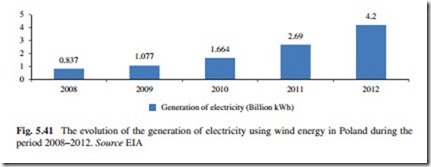Poland
According to Zervos and Kjaer (2008), progress toward the use of renewable energy sources for the generation of electricity target in Poland is slow and the penalties designed to ensure an increased supply of green electricity have not been adequately used. Despite the high potential of hydropower plants, they have not been fully used to date; biomass resources (in the form of forestry residues, agricultural residues, and energy crops) are plentiful in Poland, and landfill gas is also promising.
The Polish renewable energy policy includes the following mechanisms:
• Tradable Certificates of Origin;
• The obligation for power purchase from renewable sources involves a requirement on energy suppliers to provide a certain minimum share of renewable energy sources for the generation of electricity. Failure to comply with this legislation leads, in theory, to the enforcement of a penalty;
• An excise tax exemption on the use of renewable energy sources for the generation of electricity was introduced in 2002.
According to the Polish NREAP (2010), the country will exceed the renewable penetration trajectory set by the EU directive and exceed its 2020 binding 15 % target by 0.5 %. Renewable electricity will account for over 19 % of all electric- ity consumption, according to the document, meaning that the sector will have a larger contribution to the overall target than renewables in heating and cool- ing (17 %) and renewables in transport (10.1 %). Wind will be the technology of choice, with onshore generation meeting 8 % of total electricity consumption and offshore generation covering a further 1 %. In 2013, wind power generated 58 % of the electricity using all renewable energy sources available in the country.
At the end of 2013, the country had a wind power-installed capacity of 3,390 MW, which represents an increase of 35.8 % with respect to 2012. On the other hand,
and in accordance with the latest published data (Energy Regulatory Office), wind power-installed capacity in Poland amounts in June 2014 to 3,727 MW; this represents an increase of 9.9 %. From the beginning of 2014, installed capacity increased by 337 MW. During the past 13 years, the major increase in wind power capacity installed in the country was reached in 2001 (340 %).
However, with a cumulative capacity target of around 6.7 GW, up from over 1 GW in 2010, the Polish NREAP (2010) lacks ambition for wind.19 Despite significant growth of the wind energy sector in the recent years, it may be very difficult to meet the above targets—in particular for 2020. This is caused by the lack of regulations enabling a stable development of the wind power sector. This lack of clear legislation has slowed down new investment in new wind projects, according to Arkadiusz Sekscinski, Vice- president of the Polish wind energy association. In 2012, a total of 880 MW of new wind energy capacity was connected to the grid. In 2013, it might be half that because it was almost impossible to find financing for new wind energy projects. In the first quarter of this year, 148 MW, or 6 %, more wind capacity was connected to the grid.
However, it is important to highlight that the true market potential of wind energy in Poland by 2020 is approximately 11.5 GW onshore and 1.5 GW offshore, according to the independent Renewable Energy Institute, particularly in the North and Northwest of the country.20 These figures are much higher than those in the Polish NREAP (2010). Therefore, in the long term, the industry may substantially increase its share in the national energy mix. By 2020, the Polish Baltic should feature 1.5 GW of offshore wind farms, but the offshore energy potential is estimated at approximately 20 GW, even taking all constraints—economy, environment, military, navigation, fishing, etc.—into account. This is almost 10 times more than the installed capacity of all onshore wind farms currently operating in Poland. The estimated number of working turbines reaches 650 units.
On the other hand, EWEA’s 2009 forecast suggests that installed wind capac- ity in Poland could reach between 10 and 12 GW in the same time frame. Build- out rates for new onshore wind capacity are forecast as stable between 450 and 520 MW per year, only slightly above the 382 MW installed in 2010. The first 500 MW of offshore capacity should come online in 2020—in line with EWEA’s forecast. The wind energy target for 2020 is shown in Table 5.26.
Generation of Electricity Using Wind Energy
The evolution of the generation of electricity using wind energy in Poland during the period 2008–2012 is shown in Fig. 5.41.
According to Fig. 5.41, the generation of electricity in Poland using wind power during the period 2008–2012 increased fivefold. It is expected that the generation of electricity in the country using this type of energy source will continue increasing during the coming years.

